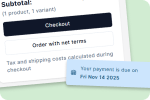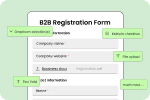Pricing for wholesale products has never been easy. Even experienced sellers, at one point or another, struggle to get it right. Often considered one of the trickiest parts of selling in bulk, together with finding reliable buyers, wholesale pricing involves getting familiar with terms like markup, margin, and cost of goods.
Not knowing how to assess pricing properly can result in prices that are either too high or too low. In either case, you are risking lost profit or missed opportunities. So, how to calculate wholesale pricing? In this article, we will walk you through everything step by step with care and in great detail. Alongside are some helpful tips, examples, and things to avoid. Read on.
Understanding Wholesale Pricing Basics
What is a wholesale price?
Wholesale price is the practice of setting a lower price for products sold in large quantities to retailers or resellers. It’s a key part of eCommerce and retail pricing because it affects both the retail price and the business’s profit margins.
The ultimate purpose of such a pricing method is to make sure that you still make a profit by selling your goods above production costs, even when offering discounts for bulk purchases, while managing to give resellers room to mark up the product.
Want to go deeper? Download our free ebook, Wholesale Pricing Mastery. It’s packed with strategies, formulas set wholesale prices to help you set profitable wholesale prices with confidence. Whether you’re new to B2B or scaling an established operation, this guide will give you the tools to maximize margins while keeping buyers happy.
👉 Get your free copy here:

What is the Difference between Retail and Wholesale?
The key difference between retail and wholesale is the customer. Retailers sell directly to end consumers (B2C), while wholesalers sell in bulk to other businesses (B2B). This distinction shapes how each operates: wholesalers focus on large, less frequent orders at lower unit prices, whereas retailers rely on smaller, more frequent purchases, earning profit through higher markups on individual items.
In the wholesale model, the sellers are usually the manufacturers, distributors, or brand owners. They sell products in bulk to a retailer. Retail, on the other hand, refers to selling directly to individual customers at a higher price point, usually one item at a time.
Because of the fundamental differences between the two, the pricing structure and profit margins also vary. Wholesale margins are generally lower, typically ranging from 15% to 50%. In contrast, retail margins are often higher, with markups ranging from 50% to 100%. But wholesale allows you to sell large volumes with less effort, whereas retailers have to sell each item one by one to individual customers.
For example, if your cost to produce an item is $10, you might set the wholesale price at $20. The gross profit, in this case, is $10 per unit. Retailers can then resell the item at a higher price, $40, for instance, and earn a $20 profit per unit.
>> B2B vs B2C Ecommerce: Key Differences and Trends in 2025
Essential Factors to Consider for Your Wholesale Pricing Strategy
So, how do you figure out wholesale pricing? Having a good strategy is essential. To be able to come up with a well-thought-out plan, you may want to keep in mind the 7 key considerations as follows:
- Cost analysis: Begin by determining the cost of goods sold (COGS). COGS includes elements like raw materials, labor, packaging, and shipping. Knowing your real costs is a crucial foundation to setting a sustainable price.
- Competitive landscape: The wholesale price should be competitive enough to attract resellers while still supporting your bottom line in the long run. Look at the market. How do others price products similar to yours? And how can you be recognized without being too expensive or too cheap?
- Market conditions: Beyond internal costs, buyers’ decisions are often affected by external market conditions. It’s important that you stay updated with shifts in demand, pricing trends, and customer behaviors.
- Fixed and variable costs: Consider all your costs carefully. In addition to direct product costs, there are also variable and fixed overhead expenses, such as rent, utilities, or team salaries. Such costs also contribute to your break-even point in wholesale pricing.
- Customer acquisition costs (CAC): CAC refers to the expenses of drawing in new customers. These spending efforts can be tracked via marketing campaigns, trade shows, or outreach efforts. Remember to include CAC in your pricing strategy to keep a healthy profit margin.
- Sales volumes and minimum order quantity (MOQ): Set a reasonable MOQ to ensure each order covers your costs and generates profit. If a buyer meets your MOQ, you can offer them more attractive pricing. In contrast, lower-volume orders may require higher pricing to remain sustainable.
- Customer value: Finally, it’s necessary to factor in the long-term value each wholesale buyer brings. You may offer flexible pricing for loyal or repeat customers. Meanwhile, a first-time or one-off buyer should be able to meet your standard margins to offset acquisition and handling costs.
>> Explore more:
15 Best Wholesale Pricing Strategies to Boost Sales
Calculating Your Wholesale Pricing: Step-by-Step Guide
In this section, we will walk you through the process of pricing for wholesale products. The step-by-step guide will break down every stage in market research, cost breakdown analysis, profit margin planning, additional cost considerations, and the wholesale pricing formula in as much detail as possible.
Midan Ventes, a Canadian distributor of eco-friendly LED lighting and smart accessories, delivers stylish and energy-efficient products for homes and modern workspaces. They faced challenges managing wholesale-specific pricing visibility to serve their B2B customers.
With B2Bridge, they solved these issues by creating customer groups tied to custom price lists, paired with a streamlined registration form and lock/hide mechanisms for access control. As a result, Midan Ventes now runs a more efficient onboarding process, provides a secure and professional wholesale portal that builds customer trust and supports business growth.

Step 1: Research Your Market
Behind every successful wholesale pricing strategy is clear, intentional market research. So, what does market research involve when it comes to wholesale pricing? There are four foundational areas in a basic market review:
Market segment: How you position your brand determines how customers perceive your value and helps set the tone for your pricing. Think about whether you’re a discount, contemporary, or premium brand. And consider which types of retailers you’re targeting. Are they boutiques, chains, or specialty stores?
Customer expectations: As mentioned earlier, pricing shapes brand perception. It’s normal for higher prices to create the impression of higher quality. Many customers are also willing to pay more if the perceived value is there, and pricing too low may hurt your perceived value.
Competitor analysis: You can’t just set a price without knowing who you’re competing with. Take a comprehensive look at similar brands in your space and try to note down their product offerings, pricing tier, and value proposition. This practice helps you avoid pricing blind spots and stretch beyond assumptions.
Marketing positioning: In parallel, consider your overall branding. How you present your products must go hand in hand with your pricing strategy. The design, packaging, and messaging should communicate the value of your product clearly through every brand touchpoint.
You can create a table or write your findings down to get a clearer picture.
Step 2: Calculate Your Production Costs
Production costs, or Cost of Goods Manufactured (COGM), are the total expense required to produce a product before it’s ready to sell. Production costs include everything in the production process, namely raw inputs and wages. The overhead necessary to produce a product is also part of COGM.
The formula for calculating COGM is: Materials + Labor + Additional costs and Overhead = COGM
For example, you have a B2B Ecommerce store whose offerings are sustainable home goods. The COGM should include:
- Materials: Raw bamboo, packaging, and shipping cartons
- Labor costs: Wages paid to your production staff or third-party manufacturers
- Manufacturing overhead: Handling and shipping raw materials and equipment wear and tear
It is also important that you get these numbers as accurate as possible right at the beginning. Any miscalculation will result in incorrect pricing and ultimately affect your profit margins.
Step 3: Set Your Target Profit Margin
The next step in how to determine wholesale pricing is to define how much you want to earn from each sale after covering your costs. There is no one-size-fits-all guide for such planning. But you can rely on the common benchmark of industry averages and factor in your business goals.
In case you need a reference point, 15% to 50% is a solid benchmark. Such wholesale profit margins are wide enough for most businesses to stay profitable and remain competitive.

Step 4: Consider Factoring in Additional Costs
Additional costs, in this context, fall under what’s called the Cost of Goods Sold (COGS) and overhead costs. COGS is the combined cost of creating and delivering a product. Simply put, it is COGM plus any costs related to packaging, shipping, and fulfillment.
Meanwhile, overhead refers to ongoing business expenses not tied to a specific product. It includes expenses like rent, customer acquisition costs (CAC), marketing spend, software tools, and utilities.
For example, you currently make $3 profit per item sold. However, that amount can vanish quickly if your overhead per sale goes beyond $3. That’s why these costs must be factored into your wholesale pricing.
Step 5: Apply Wholesale Pricing Formula(s)
What is typical wholesale pricing formula? The most basic, commonly used formula is adding your cost of goods and your desired margin.
Wholesale price = Cost of goods + Desired margin
Let’s say the total costs to produce and package your product come to $10. And you expect to make $5 profit from each item. Then, you can price the product at $15.
Looking to simplify and streamline your quoting process? Download our 12 ready-to-use Google sheets wholesale pricing sheet templates – absolutely free. These templates are crafted to help you speed up pricing, minimize errors, and close wholesale deals more efficiently.

Wholesale Pricing Methods and Strategies
While basic pricing ensures your costs are covered and you earn a profit, it doesn’t support all business types or pricing goals. To provide more flexibility and strategic alignment, several practical pricing methods and models are adopted.
Keystone Pricing
This formula is based on a fixed markup model. The principle here is quite simple: You set the retail price at double the wholesale price (100% markup over wholesale cost).
Wholesale price = Retail price / 2
One advantage of keystone pricing is that it’s easy to implement and requires little analysis. This is a traditional approach and is often employed by wholesalers who also sell DTC or supply to retailers expecting a standard markup, especially in the apparel, accessories, and gift industries.
However, keystone pricing doesn’t work very well when it comes to highly competitive markets, premium products, or niche items. This is because it doesn’t take into account market competition, customer demand, or perceived product value.
Absorption Pricing
Absorption pricing is all about covering all costs involved in producing and selling a product. Compared to basic pricing, it adds a markup to both direct and indirect costs. Because it factors in the full cost structure, absorption pricing allows for more consistent profit margins even as expenses fluctuate.
Wholesale price = Cost price + Profit margin
This type of pricing is often a reliable strategy for businesses with high overhead. Think of manufacturing companies, custom product suppliers, or wholesale distributors that handle their own production, warehousing, and logistics.
Differentiated Pricing
Next, we have the differentiated pricing model. Rather than using one fixed wholesale price, you adjust the price based on different situations and variables, such as market competition (e.g., higher prices in low-competition niches), buyer type (e.g., discounted rates for long-term partners), and order volume (e.g., reduced rates for bulk purchases).
On the plus side, it helps you offer better deals to high-volume or loyal buyers. It is also a great option for managing buyer expectations in different markets. The only downside in consideration is that differentiated pricing needs more tracking and can be harder to manage at scale.
Value-Based Pricing
Value-based pricing is another wholesale pricing strategy. How does wholesale pricing work in this case? The basis of this method is perceived value, not cost. You set your wholesale price based on what your target customer is willing to pay, then work backward to ensure your costs and margins align.
A good example is Patagonia. The outdoor clothing brand charges more because retailers know customers see the brand as high-quality and ethical.
This wholesale pricing model is often seen in premium, niche, or mission-driven product categories. It helps you protect your brand and charge more with confidence.
Competitive/Market-Based Pricing
This type of wholesale pricing focuses on aligning your prices with the current market. It uses competitor pricing as a reference point. And from there, one may decide to match, undercut, or slightly exceed depending on perceived value.
Market-based pricing is most effective in industries with similar products. Common examples are electronics, basic apparel, and home goods.
Bundle Pricing
Last but not least, we have bundle pricing. Simply put, this means selling multiple products together at one price. In wholesale, you commonly see “packs of 3” or “buy 5, get 1 free” offers as a way to move inventory and increase average order value.
The thing about bundle pricing is that it works as a volume incentive. It encourages retailers to buy more by offering better value per unit. However, it’s essential that you set the bundle price in a way that still protects your profit margin.
Want to see how these wholesale pricing strategies work in practice?
Let’s look at how Midan Ventes used B2Bridge to overcome their pricing challenges and streamline
their B2B operations
If you want more tips & method, we have put together this ebook – Wholesale Pricing Mastery
Additional Tips for Setting Wholesale Prices
Those are the basics about wholesale pricing. In the following part, we will offer you some practical tips and best practices, which are all proven to help you price smarter and sell better.
- Set a manufacturer’s suggested retail price (MSRP/RRP): If you want to guide how your products are priced across different sales channels, try to set an MSRP. MSRP is typically a recommended retail price set by the brand for resellers to follow, and it helps retailers stay consistent with your brand value while preventing underpricing wars between stockists.
- Consider a dual pricing strategy: In case your target customers are both retailers and end consumers, it’s a smart move to set one price for wholesale and another for direct-to-consumer (DTC). This strategy lends you more flexibility and avoids channel conflict
- Review wholesale prices regularly: As mentioned earlier, pricing should evolve with market conditions, cost increases, and demand shifts. Should you notice any sudden changes in customer behavior or rising operational costs, it’s high time to reassess your pricing.
- Avoid setting prices too low: How you price your products not only affects your profit but also shapes your perceived value. Setting prices too low can get you some sales initially, but it may hurt your brand badly in the long run. Stick to a relevant wholesale pricing strategy. Follow the formulas and step-by-step guide outlined above.
- Ensure competitiveness: Knowing what others are doing with their pricing strategies is also a way of staying relevant. Research and list down at least 3–5 similar players in your niche, and compare.
- Handle price negotiations: Oftentimes, you will encounter retailers asking for discounts. Retailers aim to get the best deal, so they will negotiate as low as possible. The point is you need to know your bottom line to be able to offer deals that attract buyers without hurting your profit.
Leveraging Tools for Wholesale Pricing
Even with the given formula, setting wholesale prices remains a challenging task. To those who struggle, there are various tools that help with such. Below are three recommended tools for pricing in wholesale:
- Shopify: Shopify offers a full ecosystem with built-in eCommerce tools, apps, and integrations. Regarding wholesale support, it has this Wholesale Profit Margin Calculator for quickly estimating prices based on cost and target profit. You can also explore trusted wholesale pricing apps like Wholesale Pricing Discount or Bold Custom Pricing.
- Qoblex: This pricing and inventory management platform is useful for wholesalers and distributors managing complex pricing. In particular, it lets you create multiple price lists, assign them to different customer types, and manage pricing across channels.
- WholesaleX: This is a WooCommerce-based wholesale pricing plugin. It supports tiered pricing, role-based pricing, and cart discounts. Among other notable features are catalog mode, bulk order forms, and custom registration fields.

Need Help with Your Wholesale Pricing Strategy? Contact B2Bridge Support
If setting up your wholesale pricing feels overwhelming or if you have specific questions about optimizing your B2B store, B2Bridge is here to assist you. Our expert team can guide you through the pricing formulas, strategies, and platform tools to ensure your wholesale business thrives.
Don’t hesitate to reach out for personalized support and a full walkthrough of how B2Bridge can fit your unique needs. Visit our contact page anytime to start the conversation and turn your wholesale vision into reality.
Calculating Wholesale Pricing FAQs
Yes. Many wholesalers use tiered pricing based on order size, loyalty, or customer type. Tools like Qoblex let you set custom price lists per buyer.
Wholesale pricing is typically calculated by applying a discount to the product’s retail price to cover costs and ensure profit when selling in bulk.
Yes, but always notify customers ahead. Review prices regularly to reflect costs and market shifts.
Markup is based on cost, whereas margin is based on revenue. A $70 cost sold at $100 has a 42.9% markup and 30% margin.
RRP stands for Recommended Retail Price, which is the price a manufacturer suggests retailers sell a product at.
To motivate bulk purchases, you can use volume discounts or set minimum order quantities (MOQs). But be aware of your margins so deeper discounts don’t hurt profits.
It’s best to check pricing on a regular basis to react to market changes. When you notice shifts in demand, costs, or competitor trends, make sure to adjust to stay competitive.
Yes. Platforms like Shopify let you manage both from one inventory system. Their tools will handle separate pricing and customer groups efficiently without needing two stores.
The typical formula is: Wholesale Price = Cost Price + Profit Margin.
This method ensures you cover costs and still make a profit, but it doesn’t factor in competitors’ pricing or perceived customer value – so pricing gaps may occur.
Wholesale prices are usually measured as a lower cost per unit compared to retail prices, reflecting bulk purchase savings.
The wholesale price can be found by subtracting the wholesale discount from the retail price or by using a markup formula on the cost price.
Wholesale discounts typically range from 20% to 50% off the retail price, depending on the industry and product.
The average wholesale price varies widely by product category but is generally lower than retail prices by a significant margin to allow retailer profits.
Wholesale margin is calculated as (Wholesale Price – Cost Price) ÷ Wholesale Price × 100%, indicating the profit percentage on wholesale sales.
Conclusion
That sums up everything you need to know about wholesale pricing. Hopefully, you now understand the core principles and feel equipped with practical knowledge on how to price your wholesale products. The bottom line is knowing your numbers. As long as you keep your costs, margins, and market in check, you’ll be just fine.Interested in scaling your B2B business? Visit B2Bridge.io for more insights on B2B selling.
Not sure which wholesale pricing approach fits your business best? Our team at B2Bridge can help you design a pricing model tailored to your products, margins, and buyers.
Contact us to get expert guidance and practical solutions for your wholesale store.

Hi, I’m Tri, a tech enthusiast. With over 4 years of hands-on experience with Shopify and a total of eight years in technology and ecommerce, I currently serve as a Technical Leader on Shopify app development projects. My goal is to contribute solutions that are user-friendly, stable, and scalable within the Shopify App ecosystem.






